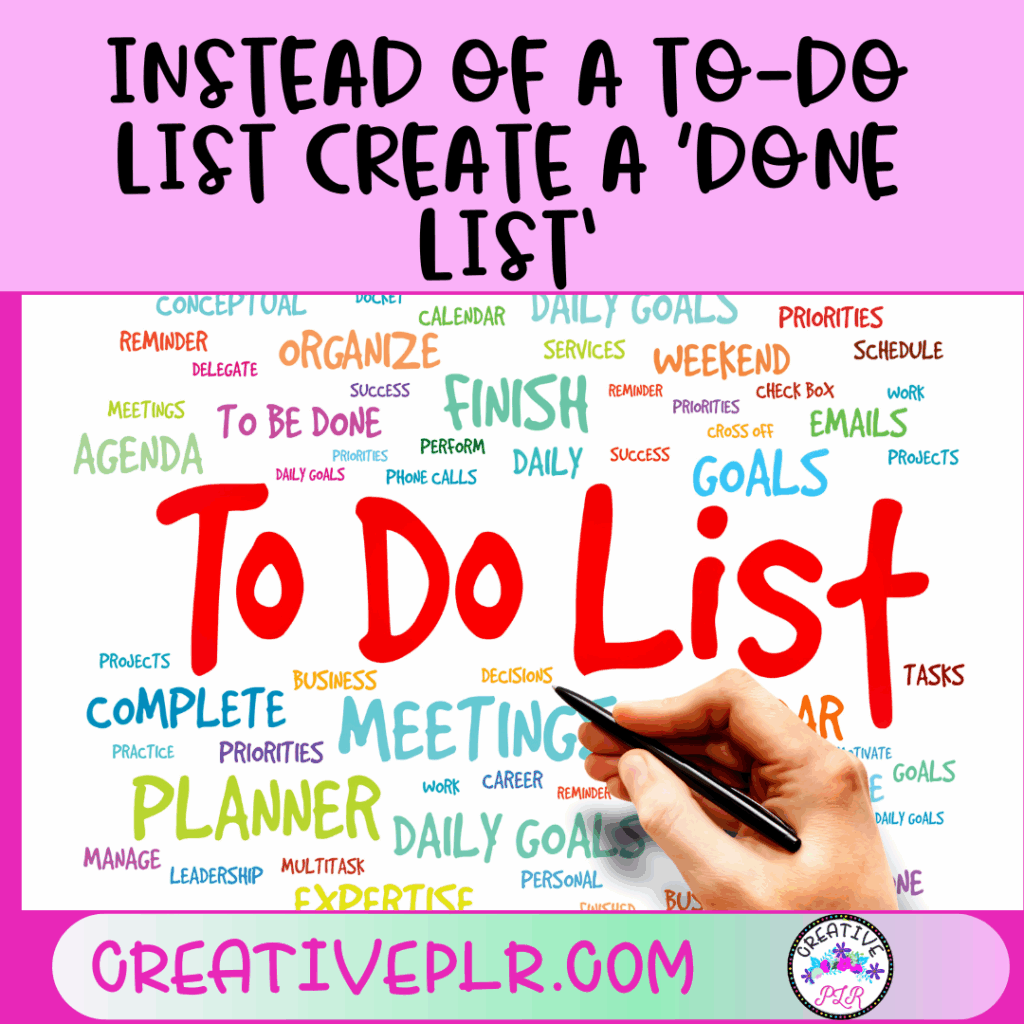There’s something oddly satisfying about crossing items off a to-do list. Yet, more often than not, those lists leave us feeling stressed, guilty, or overwhelmed when tasks remain unfinished.

The constant cycle of incomplete lists can hurt productivity more than helping it. Especially if you focus on the negative–what did not get done. Enter the ‘Done List’ — a simple yet effective method to transform how you perceive your accomplishments and stay motivated. E
The Problem with Traditional To-Do Lists
To-do lists have been a productivity staple for decades. Yet, as convenient as they seem, they create more problems than they solve. From unrealistic expectations to lingering guilt over unfinished tasks, these lists often work against us.

The Productivity Fallacy
The biggest mistake people make with to-do lists? Assuming they make you more productive. In reality, most people add far more tasks than they can reasonably handle in a day. Completing smaller, less meaningful tasks may feel good temporarily, but it doesn’t always lead to progress on your bigger goals.
It’s like running on a treadmill. You’re moving, but you’re not actually getting anywhere.
The Guilt of Incompleteness
What happens when you don’t check off everything? Guilt creeps in. You might end your workday focused not on the things you achieved but on all the unchecked boxes staring back at you. Over time, this guilt can chip away at your motivation and make you dread even starting the next list.
How To-Do Lists Lead to Overexertion
Ever find yourself squeezing just “one more thing” onto your already packed to-do list? It’s common to overestimate energy and time, trying to jam a week’s worth of work into a single day. This overexertion leads to stress, burnout, and a cycle where you constantly feel you’re falling short.
What Is a ‘Done List’ and How Does It Work?
This is where the ‘Done List’ flips the script. Instead of obsessing over what’s left to do, the ‘Done List’ focuses on what you’ve already accomplished.
It’s even more valuable to keep the list/journal and reflect back after some time has passed. You will see shifts in productivity, you will see many tasks done, and you will feel accomplished.
Defining the Done List
A ‘Done List’ is exactly what it sounds like: a running list of tasks you’ve completed. But it’s more than just a log — it’s a reflection tool. Its purpose is to draw attention to your daily progress, no matter how big or small, and give you a sense of fulfillment.
Unlike traditional to-do lists, which focus on future obligations, the ‘Done List’ is rooted in the present and celebrates your efforts retrospectively.
How to Start a ‘Done List’
Getting started is easy. Here are some simple steps:
- Choose Your Format: Keep it digital (like an app or a notes doc) or go old-school with a notebook.
- Log Daily Accomplishments: Jot down everything completed during the day, from major milestones to tiny wins.
- Review Regularly: At the end of the week, revisit your list. It’s a great way to appreciate your progress and identify patterns in how you work.
Prioritizing Reflection Over Planning
The beauty of a ‘Done List’ is how it shifts your focus. Instead of stressing about what you didn’t accomplish, you reflect on what you did get done. This boost in self-awareness can even help you plan better because you have real data on how much you’ve handled before.
Benefits of Using a ‘Done List’
Adopting a ‘Done List’ can do wonders for your mindset, work habits, and overall productivity. I love the feeling of seeing what I’ve accomplished instead of a long list of things still hanging over my head. Let’s explore some of its most impactful advantages.
Boosting Motivation and Satisfaction
There’s something undeniably motivating about seeing a list of completed tasks. It’s proof of your hard work and a reminder that you’re capable of following through. Each accomplishment builds momentum, making you eager to tackle the next challenge.
Encouraging Mindful Productivity
Mindful productivity is about working smarter, not harder. When you reflect on completed tasks, you’re more likely to notice patterns in your workflow. This allows you to approach future projects more thoughtfully and with a clear focus on what matters.
Reducing Stress and Burnout
When you’re only concerned with incomplete tasks, it’s easy to feel like you’re failing. A ‘Done List’ flips that narrative. By celebrating what’s finished, you reduce the stress of feeling “behind.” This shift can help you maintain a healthier relationship with work. Check out more benefits with this ARTICLE.
Combining a Done List with Goal Setting
What’s great about a ‘Done List’? It doesn’t mean you need to ditch all planning. Instead, you can pair it with goal-setting to stay grounded and intentional.
Breaking Goals into Actionable Tasks
When you regularly review your ‘Done List,’ you start noticing patterns in your work. Maybe certain tasks took longer than expected, or specific types of work drained your energy. Use this insight to break down future goals into manageable steps that match your strengths.
Balancing Short-Term Wins with Long-Term Objectives
A ‘Done List’ is ideal for balancing the here-and-now with your bigger picture. While checking off small wins can feel rewarding in the moment, regularly aligning your ‘dones’ with your long-term goals ensures you’re progressing in the right direction.
The traditional to-do list might be productivity’s favorite tool, but let’s admit: it’s not working for everyone. A ‘Done List’ offers a refreshing alternative, helping you focus on progress instead of perfection. By celebrating daily wins, you’ll boost motivation, enhance mindfulness, and reduce workplace stress.
Why not give it a try? Start logging your accomplishments today and feel the difference for yourself.